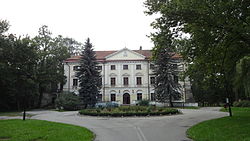Koniecpol
Place in Silesian Voivodeship, Poland From Wikipedia, the free encyclopedia
Koniecpol [kɔˈɲɛt͡spɔl] is a town in Częstochowa County, Silesian Voivodeship, in southern Poland, with 5,910 inhabitants (2019). It is situated on the Pilica River,[2] in the historic Sieradz Land.
Koniecpol | |
|---|---|
 Potocki Palace | |
| Coordinates: 50°47′N 19°41′E | |
| Country | Poland |
| Voivodeship | Silesian |
| County | Częstochowa |
| Gmina | Koniecpol |
| Town rights | 1443 |
| Area | |
• Total | 36.52 km2 (14.10 sq mi) |
| Population (2019-06-30[1]) | |
• Total | 5,910 |
| • Density | 160/km2 (420/sq mi) |
| Time zone | UTC+1 (CET) |
| • Summer (DST) | UTC+2 (CEST) |
| Postal code | 42-230 |
| Vehicle registration | SCZ |
| Climate | Dfb |
| Website | www.koniecpol.pl |
History

It was granted town rights by King Władysław III Warneńczyk in 1443.[2] Koniecpol, also known as Nowopole, was a private town, administratively located in the Radomsko County in the Sieradz Voivodeship in the Greater Poland Province of the Kingdom of Poland.[3] It was the seat of the Koniecpolski magnate family, and later it passed to the Czapski and Potocki families.[2] In the 16th century, King Sigismund II Augustus established four annual fairs.[2] In the 17th century, Hetman Stanisław Koniecpolski built the landmark Baroque Holy Trinity church.[2]
Following the joint German-Soviet invasion of Poland, which started World War II in September 1939, it was occupied by Germany until 1945. The occupiers operated a camp for Romani people in the town.[4]
Twin towns – sister cities
Notable residents
- Henryk Poddębski (1890–1945), Polish photographer and local historian
References
External links
Wikiwand - on
Seamless Wikipedia browsing. On steroids.



